
views
Exercising Your Abs

Keep your stomach in and stable while working out. Your abs are involved in almost every single exercise to do, and you can speed up your gains by focusing on your abs with every exercise. To do so, focusing on keeping your belly button "in" (towards your spine) and flexing your abdominal muscles as you work-out. Whenever you are doing and ab workout, think about having a strong core -- moving fluidly from your core in a straight line, no matter what your exercise. Think of you body like an engine piston, making the same steady motion each time.
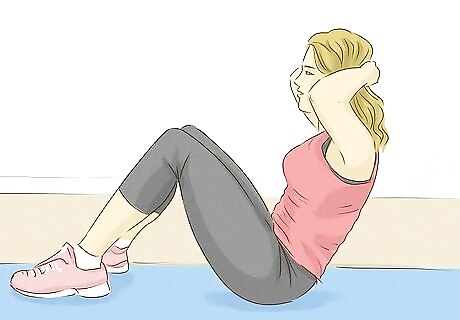
Do sit-ups. The most famous ab workouts are sit-ups, and for a reason -- they work your abs directly. For sit-ups, lie down with your feet on the floor, knees up, and hands crossed on your chest. Sit all the way up, bringing your shoulders to your knees while keeping your back straight. Lower yourself down slowly, with control, and repeat 20 times. Once these become easy, hold onto weights or a resistance band to make them harder. While it is popular, do not have someone hold your feet down -- this works your hip muscles more than your abs.
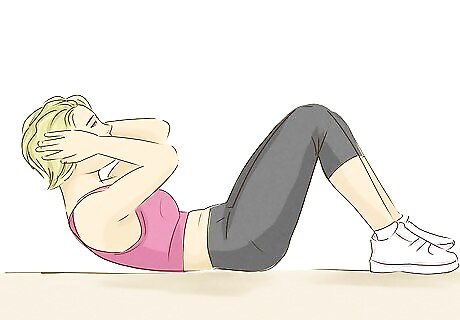
Do crunches. The quality of your crunches matters more than the quantity. Lying on your back, with your knees up and feet down, slowly bring your shoulders up towards the ceiling. Keep your back on the floor and your neck strong. As you raise, exhale and hold your shoulders 6–8 inches (15.2–20.3 cm) above the floor. Slowly lower your shoulders, but try not to touch your head to the floor. As you go back down, inhale. Do 20 repetitions. Breathing is essential for effective crunches—be sure that your exhalations and inhalations as you crunch up and come back down are very slow. Work the sides of your abs with side-crunches. After raising your shoulder, twist from your abs to the side so that your elbow touches the floor. Without returning to the floor, twist to the other side as well, Touch each side 15-20 times. Bicycle crunches, are even harder: pick your legs up off the ground, bending your knees so that your lower legs are parallel to the ground. With every crunch, alternate pumping your legs as if you were riding a bike.

Do leg lifts. Lay on your back on the ground with your hands by your sides. With your feet together, raise your legs from the waist, trying to form an "L" with your body. Slowly lower them back to the floor, stopping 2–3 inches (5.1–7.6 cm) from the ground before repeating 19 more times. Keep your legs straight throughout the exercise. For a challenge, do a "hanging leg lift." Hanging from your hands off of a pull-up bar, raise your straight legs up until your body forms an "L." You can add weights or hanging medicine balls as well to make the exercise harder.
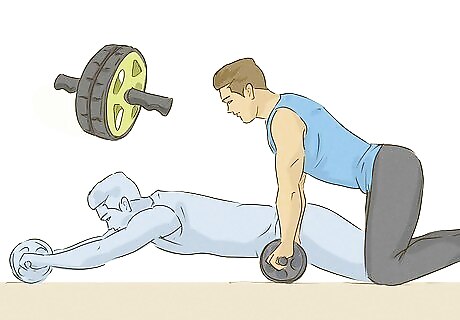
Use an ab roller for concentrated ab workouts. Hold the ab roller with both hands while in a push-up position. Slowly push the ab roller out away from your body, extending your arms. Go down as far as you can without touching your torso to the ground. Then slowly return to the center by bringing your hips and butt into the air and rolling your hands towards your feet. If you don't have an ab roller, use rounded barbell weights instead.
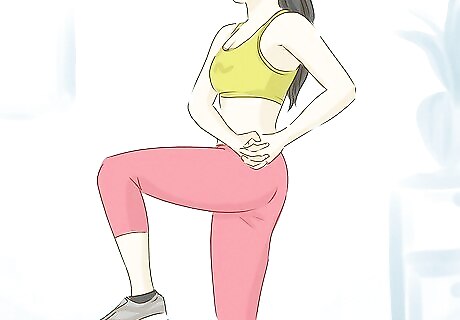
Try a canoe twist. Stand with your feet should length apart. Twisting from your waist, turn your shoulders and arms to one side as if you were rowing a canoe. Simultaneously, raise your opposite knee towards your chest. Alternate sides 20 times.
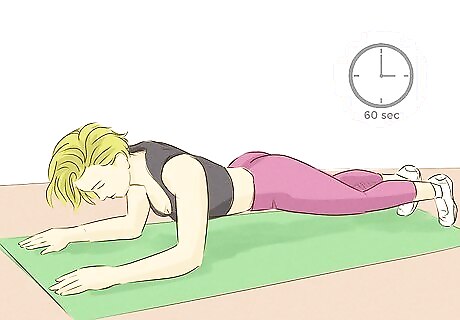
Do planks to work your obliques. Though not part of the classic "six-pack," strong obliques are essential to good abs. To do a plank, set-up in push-up position. However, instead of resting on your hands, fold your arms horizontally in front of you and rest on your elbows and forearms. Keep your spine straight and your butt at the same height as your shoulders. Hold this for one minute, rest, and repeat two more times. Make planks more difficult by adding "toe-taps:" lift one foot off the ground 6 inches (15.2 cm) and return it slowly. Lift each foot 20 times.

Try side-planks to work your entire core. Side planks target one side of your body and your abs, and are incredibly effective exercises. Turn so that your chest faces sideways. Rest your weight on the outside of your foot foot and your forearm. If you were to draw a line from the floor through your shoulders it would point straight up to the sky. With the opposite arm flat against your side, hold this position for one minute, keeping your body in a straight diagonal line up from the floor.
Developing Good Habits
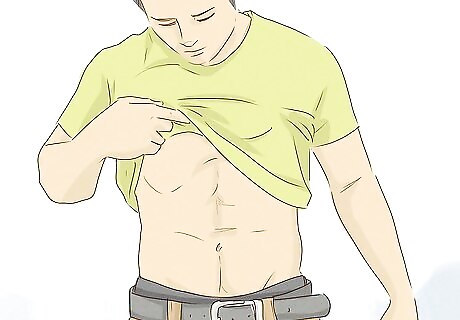
Have realistic expectations about your body. Unfortunately, not everyone can have Beyonce's body. Genetics, to some extent, play a role in developing your six pack. Similarly, if you work 70-80 hours a week you might not have enough time for killer abs. Having great, flashy abs may not be possible for everyone -- but having healthy, strong abdominal muscles is a realistic goal for all.
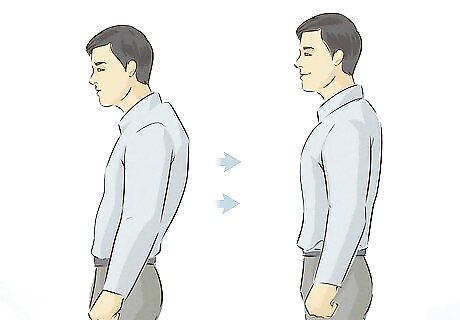
Focus on your posture. Slouching will make it look like you have a beer belly no matter how much you work out. Stand tall with your shoulders back to make the most of your abs. Think of your posture as creating a simple line with your body-- this will lead to a flat stomach and great abs: Ears over your shoulders. Shoulders over your hips. Hips over your knees. Knees over your ankles.
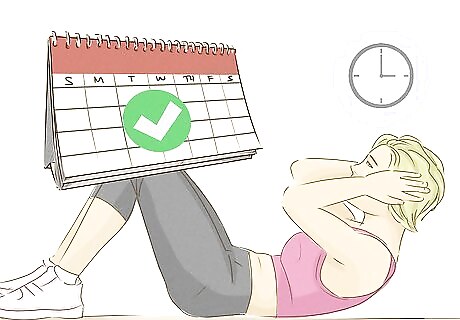
Make time for ab exercises daily. Having great abs does not require you to go to the gym every day. You can find time to do ab workouts throughout your day to make sculpting your abs a part of your daily life. Perform 20 sit-ups, 20 push-ups, and 2 minutes of planks during commercial breaks on TV. Take a break from the computer and do 20 crunches every hour during work. Perform 10-15 minutes of simple exercises right when you wake up in the morning, or before bed. Take the stairs, run to work, or bike to the store whenever possible.
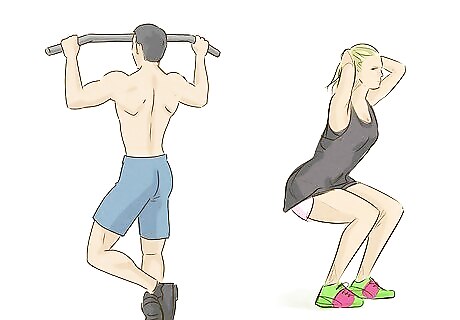
Train your whole body. Your abs sit at a crucial place in your muscular system, helping transfer energy and motion from you upper body to your hips and legs. As such, it is hard to get great abs without working out the rest of you body as well. This doesn't mean you need to go to the gym every day, though this will help. You can also perform body-weight exercises at home. All of these exercises utilize your core, though it is not the principle muscle. Push-ups: Place your toes and both hands (shoulder length apart) on the floor. Focus on keeping your spine straight as you lower yourself to the ground so your nose is roughly 6 inches (15 cm) from the floor. Slowly push back up to your starting position. Aim for 20 reps. (Biceps, Triceps, Pecs) Pull-up: Grip a horizontal bar with both hands so your palms face towards you body. Using your arms, pull your chin above the bar and slowly lower yourself down. Aim for 5-10 reps. (Biceps, Triceps, Deltoids) Wall Sits: Sit as if you were in a chair with your back against the wall. Your legs will form a right angle at the knee and you back should stay straight against the wall. Hold for one minute at a time. (Quads, glutes). Squats: With your feet shoulder length apart, slowly lower your butt to the floor. Try to keep your knees directly in line with your ankles, not leaning over them. Slowly return to standing position. This exercise is great with weights as well. Aim for 15-20 reps. (Quads, Hamstrings, Glutes).
Flattening Your Stomach
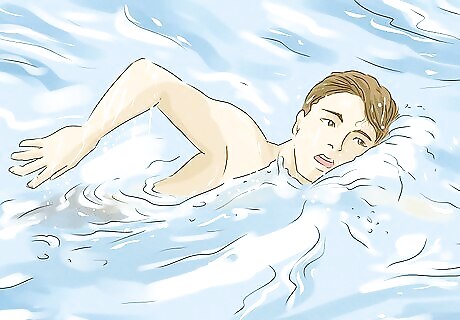
Do a cardiovascular workout 4-5 times a week. Cardiovascular exercise, or "cardio," is any exercise that raises you heart-rate for an extended period of time. It can be running, swimming, biking, dancing, or playing pick-up soccer with some friends. Aim for 3-4 hours of cardio a week, at minimum, to start seeing your stomach flatten. Interval training is a workout that requires short bursts of vigorous activity followed by longer periods of low activity, like jogging around a track and sprinting every 4th lap. Researchers believe that interval training helps burn fat four times faster than exercising at the same intensity for longer times.
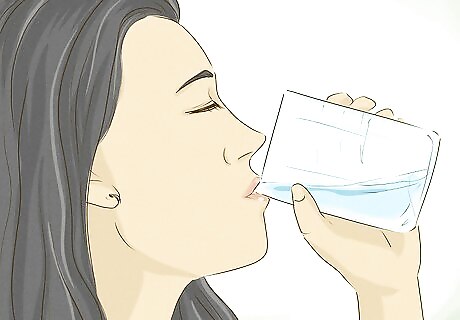
Drink plenty of water. Water is essential to build muscle, aid digestion, and fuel workouts. You should be drinking between 24 and 36 ounces of water every day. It may also have the benefit of helping lose weight by limiting over-eating.
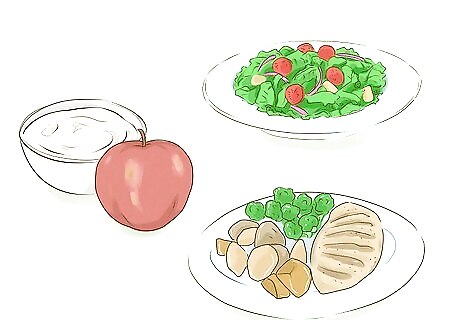
Eat small, healthy meals. Fruits and vegetables, whole grains, and a little protein are all that a good diet requires. Try to eat smaller meals, eating more frequently if you need, as this keeps you from eating too many calories at once and feeling bloated. Substitute baked potatoes for a side salad. Eat yogurt and granola in the morning instead of eggs and cheese. Cut back on red meat and eat chicken or turkey instead. Plan small snacks like fruit and vegetables to keep from hungrily over-eating during a meal. Eat slowly -- it takes 20 minutes for you to feel "full," but if you eat quickly you'll continue eating food until this point.
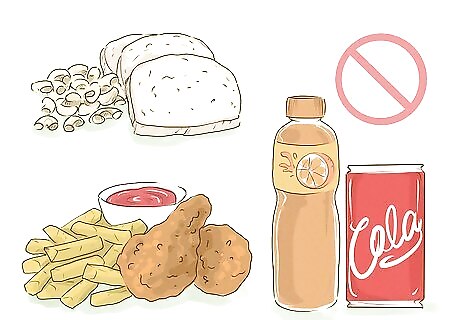
Avoid high-calorie, low nutrition foods like sweets and fats. While they may taste good, donuts, cake, and soda will eliminate any gains you've made by working out and prolong your goal of great abs. Some foods to avoid include: Refined carbohydrates, such as white bread, pasta, and rice. Processed Sugars, found in sweetened juices, soda, and candy, are absorbed quickly into the bloodstream but brings your metabolism to a crawl. Saturated Fats, found in fried food, fatty red meat, and most fast-food.
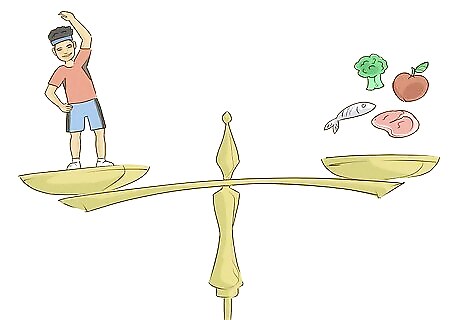
Balance your exercise and diet to lose more calories than you eat. The formula for losing weight is easy-- you need to burn more calories than you eat. This is why exercise and limiting fatty foods is so important. Running two miles can eliminate 250 calories, but eating one slice of cake might add 350 more. There are 3,500 calories in a pound of fat, so you can use this number to plan your diet: eliminate 500 extra calories a day and you can lose a pound of fat a week. If you maintain similar diet each day, simply adding 30 minutes of daily exercise will burn away calories and flatten your stomach over time. Similarly, switching from a high-calorie breakfast like bacon and eggs to sometime like yogurt and granola will decrease you "net calorie" use significantly. Use a fitness tracker, like Nike Fit, Fitbit, or MapMyRun to monitor how many calories you burn when you exercise.


















Comments
0 comment